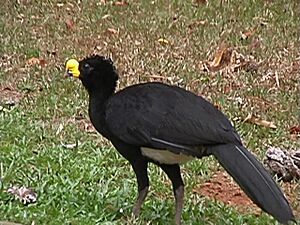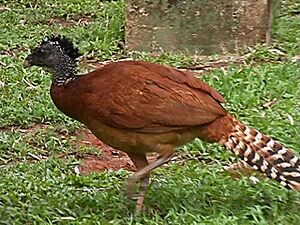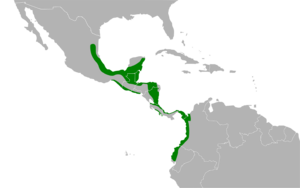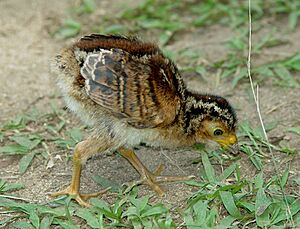Great curassow facts for kids
Quick facts for kids Great curassow |
|
|---|---|
 |
|
| Male | |
 |
|
| Female | |
| Conservation status | |
| Scientific classification | |
| Genus: |
Crax
|
| Species: |
rubra
|
| Subspecies | |
|
|
 |
|
| Synonyms | |
|
|
The great curassow (Crax rubra) is a big, pheasant-like bird that lives in the rainforests of Central and South America. You can find them from eastern Mexico all the way down to western Colombia and northwestern Ecuador.
Male great curassows are black with cool, curly feathers on their heads and bright yellow beaks. Female birds can look very different! Some have stripes (barred), some are reddish-brown (rufous), and others are mostly black.
These birds often hang out in small groups. They usually look for food on the ground, eating fruits and insects. Sometimes, they might even catch a small animal. But when it's time to rest or build a nest, they go up into the trees.
Great curassows are monogamous, which means a male and female bird stay together as a pair. The male often builds a small nest from leaves where the female lays two eggs. Sadly, these birds are facing threats like losing their homes (habitat) and being hunted. Because of this, the International Union for Conservation of Nature says they are a "vulnerable" species, meaning they need our help to survive.
Contents
What Do Great Curassows Look Like?
The great curassow is a very large bird! It can be about 78 to 100 centimeters (31 to 39 inches) long. That's almost as tall as some kids! They weigh between 3.1 and 4.8 kilograms (6.8 to 10.6 pounds). Females are usually a bit smaller than males.
This bird is one of the heaviest birds in its family, called cracids. Other curassows, like the northern helmeted and black curassows, are similar in length.
Male and Female Differences
Male great curassows are easy to spot. They are all black with a cool, curly crest of feathers on their head. They also have a white belly and a bright yellow, bumpy knob on their beak.
Female great curassows can look quite different from each other. There are three main types, called morphs:
- Barred morph: These females have stripes on their neck, back, wings, and tail.
- Rufous morph: These females are mostly reddish-brown with a striped tail.
- Dark morph: These females are mostly black, sometimes with faint stripes on their wings.
In most places, you'll only see one or two of these female types.
Their Calls
Great curassows have a special call. It's a long, whistling sound that is quite unique.
Life and Habits of the Great Curassow
Great curassows are found in the rainforests from eastern Mexico through Central America to western Colombia and northwest Ecuador. Even though they spend a lot of time on the ground, they build their nests and sleep in trees.
These birds like to be social. They often live in groups of up to twelve birds, but sometimes you might see one by itself.
What Do They Eat?
Their main food is fruits, especially figs. They also eat arthropods (like insects and spiders). Sometimes, they might eat small animals like rodents. Unlike some other birds in their family, great curassows mostly eat fruit that has fallen to the ground, instead of picking it directly from trees.
Reproduction and Life Cycle
Great curassows are monogamous, meaning a male and female bird form a pair. The male might build the nest to impress the female, or sometimes both birds work together.
They usually lay two eggs in a small nest, which is often made mostly of leaves. Each egg is quite large, about 9.1 by 6.7 centimeters (3.6 by 2.6 inches) and weighs about 200 grams (7 ounces).
When a great curassow chick hatches, it weighs about 123 grams (4.3 ounces). By the time it's six months old, it will weigh around 2.7 kilograms (6 pounds). When they are about a year old, they are fully grown and independent, weighing about 3.6 kilograms (8 pounds).
Staying Safe from Predators
Great curassows can be quite protective, especially when they have chicks. They might act aggressively to scare away predators. Animals like ocelots (wild cats) and ornate hawk-eagles are known to hunt adult curassows. Chicks and eggs have even more predators.
If a predator gets too close to their young, curassows might pretend to be hurt to distract the danger. In captivity, these birds have lived for at least 24 years!
How Great Curassows Evolved
The great curassow is the Crax species that lives furthest north. Their ancestors lived in northern South America about 9 million years ago. As the Colombian Andes mountains grew taller around 6 million years ago, some of these birds became separated from others. The separated group eventually became the blue-billed curassow.
The ancestors of today's great curassows then spread along the Pacific side of the Andes and into Central America. This happened during a time when many animals moved between North and South America.
Conservation Status
The great curassow is listed as "Vulnerable" on the IUCN Red List of Threatened Species. This means their numbers are decreasing, and they could become endangered if we don't protect them. The main reasons for this are that their homes (habitats) are being destroyed and too many are being hunted.
This bird is also protected by an international agreement called CITES in countries like Costa Rica, Guatemala, Colombia, and Honduras.
There's a special type of great curassow called C. r. griscomi that lives only on Cozumel Island. There are only a few hundred of these birds left. Their population sometimes goes up and down, and they are very sensitive to strong storms like hurricanes.
Interestingly, great curassows can have babies with their closest relatives, the blue-billed curassow. They can even have babies with the more distant black curassow. These babies can also have their own young.
In Mexico, there are special places called "Management Units for the Conservation of Wildlife" (UMAs). These places are working to breed great curassows in captivity to help their numbers grow.




